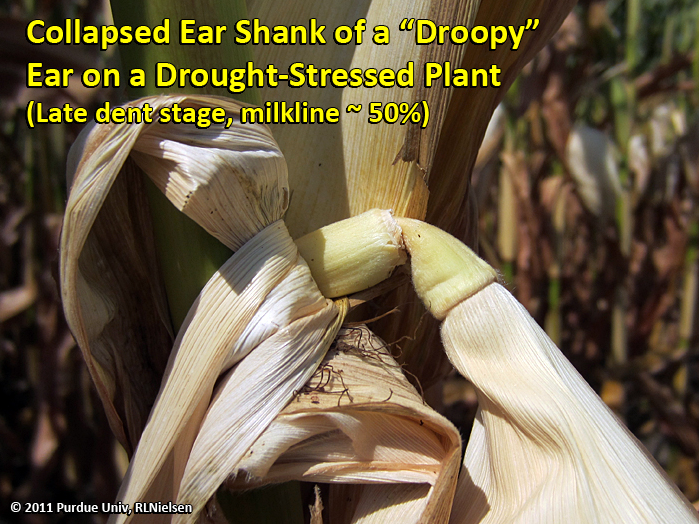Droopy ears are cute on certain breeds of dogs, but droopy ears on corn plants prior to physiological maturity are a signal that grain fill has slowed or halted. Ears of corn normally remain erect until some time after physiological maturity (black layer development) has occurred, after which the ear shanks eventually collapse and the ears decline or “droop” down. The normal declination of the ears AFTER maturity is desirable from the perspective of shedding rainfall prior to harvest and avoiding the re-wetting of the kernels. PREMATURE ear declination, however, results in premature black layer formation, lightweight grain, and ultimately lower grain yield per acre.
What Causes Premature Droopy Ears? The most common contributing factor seems to be severe drought stress that extends late into the grain filling period. Indeed, I discovered droopy ears in a June-planted corn field (full dent stage, no visible milk line yet) the other day in westcentral Indiana, an area of the state that has been abnormally dry for at least a month. Last week’s sunny days with warmer than normal temperaturates caused higher than normal evapotranspiration demands on the late-developing crop.
The “droopy” symptom suggests a loss of turgidity in the ear shank due to stress, possibly combined with some cannibalization of the ear shank similar to what can occur with the stored reserves of the main stalk in response to severe photosynthetic stress. Eventually, the ear shank collapses and the ear droops down.
Flashback: In hybrids without the Bt-corn borer trait, collapsed ear shanks can also result from extensive tunneling by European corn borer larvae. Such tunneling weakens the ear shank, allowing it to collapse, and can ultimately also cause the ear to literally drop from the plant.
Impact on Yield? Remember that the ear shank is the final “pipeline” for the flow of photosynthates into the developing ear. An ear shank that collapses prior to physiological maturity will greatly restrict, if not totally prevent, the completion of grain fill for that ear and will likely cause premature black layer development in the grain. If the droopy ears have not yet black layered, they will black layer prematurely; sooner than neighboring erect ears.
The timing of the onset of the collapsed ear shanks determines the magnitude of the expected yield loss. If grain fill were totally shut down at the full dent stage of grain development (milk line barely visible at dent of kernels), the yield loss would be as much as 40 percent. If grain fill were totally shut down at the late dent stage of grain development (milk line halfway between dent and tip), yield losses for the affected ears would equal about 12 percent.
Multiplying the percentage of affected ears in a field by the estimated yield loss per ear will give you an estimate of whole field loss. For example, if ten percent of the field contained plants whose ears drooped prematurely at the late dent stage, whole field loss would be estimated at 1.2 percent (10 percent of the ears multiplied by 12 percent yield loss per ear).
Final thought: While it is never enjoyable assessing the yield potential of drought-stressed fields, it does serve a purpose in helping you develop your grain marketing strategy. Let this article serve as a reminder that the proverbial “windshield survey” often fails to provide an accurate assessment of crop condition.
Related reading
Nielsen, RL (Bob). 2012. Opportunities to Assess Yield Potential of Drought-Stressed Corn. Corny News Network, Purdue Univ. http://www.kingcorn.org/news/articles.12/YldAssessment-0727.html [URL accessed Sep 2019].
Nielsen, RL (Bob). 2018. Estimating Corn Grain Yield Prior to Harvest. Corny News Network, Purdue University. http://www.agry.purdue.edu/ext/corn/news/timeless/YldEstMethod.html. [URL accessed Sep 2019].
Nielsen, RL (Bob). 2019. Grain Fill Stages in Corn. Corny News Network, Purdue University. http://www.agry.purdue.edu/ext/corn/news/timeless/GrainFill.html. [URL accessed Sep 2019].









